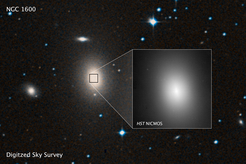Galaxy with a huge black hole is a hermit
Massive black holes reside at the centre of almost all galaxies – the one at the heart of our Milky Way is one of the smaller ones, with a mass of “only” 4 million times larger than the Sun. In the distant and early universe, black holes a thousand times more massive than the one in the Milky Way centre power quasars, or quasi-stellar objects: powerful beacons whose energy is released by the accretion of gas onto the massive black holes causing them to outshine their host galaxies by many orders of magnitude. Until now, the dormant descendants of these very massive black holes typically have only been found in gigantic galaxies at the centres of massive clusters of galaxies with hundreds of other galaxies. What has become of all the other accreting big black holes today?

The elliptical galaxy NGC 1600 (left) harbours a very massive black hole with 17 billion times the mass of the Sun. Unlike other galaxies, where very massive black holes have been found (like NGC 4889, right), it is the largest of a small group of galaxies and not in a rich cluster.
One of them – and an extremely massive one – has now been found: the centre of the galaxy NGC 1600 harbours a black hole with a mass 17 billion times larger than that of our Sun. This is one of the largest black holes found to date. The astronomers used observations from the MASSIVE survey, which aims to study the structure, dynamics, and formation history of the 100 most massive early-type galaxies within about 350 million light-years of our Milky Way. In particular, the astronomers measured the stellar velocities near the black hole which were then fed into models for stellar orbits to determine the mass of the black hole.
The huge mass of the black hole combined with the fact that NGC 1600 is part of a relatively small group of only a few galaxies makes this discovery exciting: “This is the first time that we find such a massive black hole in a relatively isolated galaxy, outside a rich galaxy cluster”, states Jens Thomas from the Max Planck Institute for Extraterrestrial Physics, lead author of the study now published in the journal Nature. “Other galaxies found to harbour very massive black holes are typically located in dense regions of the Universe populated by many other galaxies and clusters,” says Jens Thomas. NGC 1600 is the brightest member of its group and outshines the other members by at least three times. To grow so big it may have had a head start, merging with its former close-by galaxies and their central black holes early on.

Close-up of the central region of NGC1600. The core is quite diffuse as if a lot of stars are missing – probably as the result of a previous galaxy-galaxy merger.
“Equally astonishing is the centre of the galaxy: it is very diffuse, as if billions of stars are missing.” says Chung-Pei Ma, from the University California Berkeley, USA, who leads the MASSIVE Survey. Massive galaxies like NGC 1600 and their black holes typically grow through mergers and the aftereffects of such a galaxy merger could remove stars from the centre: the two black holes of two merging galaxies are believed to form a binary before they ultimately merge, and stars passing close-by are scattered to larger radii due to gravitational slingshots. “Less massive elliptical galaxies typically get brighter and brighter the closer you get to the centre, but in NGC 1600 it’s like the equivalent of all the stars of the Milky Way disk have been removed,” Jens Thomas explains.
By comparing their result with mass determinations of a sample of other core galaxies, the astronomers found that the radius of the region with depleted stellar densities is indistinguishable from the gravitational sphere of influence of the black hole. The core radius seems to be a better indicator of black hole mass than other galaxy properties.
“The black hole in NGC 1600 is the first example of a possible descendant of a luminous quasar in a relatively isolated galaxy,” says Chung-Pei Ma. “There are quite a few galaxies of comparable size that reside in average-sized galaxy groups. At the moment we do not know if such very massive black holes are common in other nearby massive galaxies as well. Our ongoing observations will soon reveal if our discovery is a rare find or just the tip of an iceberg.”
NGC1600 and its group of galaxies













